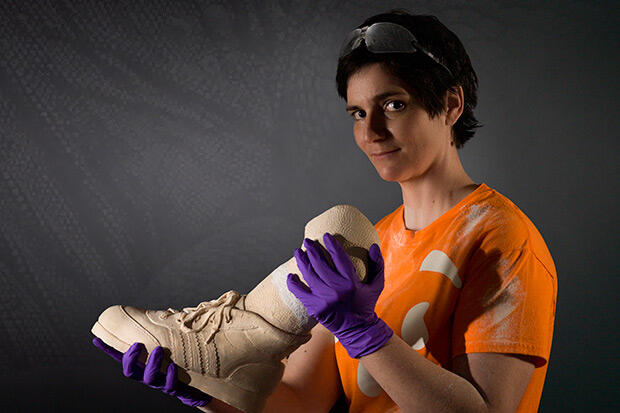
April 14, 2014
True detective: Michelle Florence
Art student learns how to apply armatures in large-scale figurative ceramics
Share this story
Imagine a large clay sculpture of a giant iguana smoking a cigarette on roller skates on a lit disco floor platform.
Once complete, it will be the latest creation from Michelle Florence, an undergraduate student in the Department of Craft/Material Studies in the Virginia Commonwealth University School of the Arts.
“My work is reactionary and metaphorical,” said Florence, who has a concentration in ceramics. “More often than not, I'll try to describe a thought or idea in conversation and an image pops to mind. I make the image real.”
Florence has been working with clay as a medium in the creation of large-scale ceramic sculpture with a focus on gaining a practical understanding of large armatures and the structure and stability of a sculpture.
An armature is a rigid structure used to support a softer, more supple material, such as clay, for sculptural purposes.
“In contemporary ceramics, artists utilize armatures to create large figurative ceramic sculptures through the process of sculpting a solid form which is dried to leather hardness for structural strength and then removed in sections from the armature, hollowed out and reassembled,” Florence said.
Early last year, she decided she wanted to spend her summer months in the studio with her hands immersed in clay, rather than working for an hourly wage elsewhere.
So when she heard of the Undergraduate Research Opportunities Program, she went for it.
“All learning is good learning,” she said.
“Any opportunity to gain greater technical expertise with the material is important at this stage. It also gave me the opportunity to learn the responsibilities and logistics of working independently through ordering my own supplies and managing a budget.”
Through the UROP fellowship, Florence is being mentored by Andréa Connell, assistant professor of ceramics in the Department of Craft/Materials Studies. From Connell, Florence has gained technical expertise, such as knowledge about what type of clay body to use, how to figure out how much material is needed for a project, the type of epoxies to use and how to use them, how to treat a surface, and much more.
“Working at this scale provided Michelle with the knowledge, technical skill and confidence needed to build anything,” Connell said.
“One of the most important things that UROP does is provide an undergraduate student with the understanding that their ideas are valuable and worthy of exploration. This tells me that VCU believes in the potential of their students, and their faculty,” she said.
The hands-on project has had a positive impact on the way Florence views her field.
“It’s brought to my attention the use of scale in the field of sculptural ceramics. It’s one thing to know how to build big, but it’s also important to consider why and if it is the appropriate means to communicate concept,” Florence said.
Her sculpture, which is titled, “Untitled: incense burner as seen on Etsy,” is a work in progress. The bulk of the figure has been fired. Florence is utilizing 3D printing to design and print a master of the roller skate wheel in order to make a press mold to produce all 16 wheels needed. She has also started work on the platform, such as ordering plexiglass and researching LED lighting systems.
“The tight curriculum that we have does not always allow for independent research, and we certainly cannot cover all technical possibilities in the classes provided,” Connell said.
“This kind of large-scale work is simply not within our budget or our studio capacity to have every student participate – therefore, it is essential that opportunities like this exist so that students with these specialized interests can pursue their desires. This project gave Michelle the time and funding to pursue a project that would have been impossible to fulfill in class.”
Florence’s experience has taught her patience and time management, while she juggles other academic demands and priorities.
And it’s been transformative, she said. She’s gained “more confidence … and more gray hair.”
Subscribe for free to the weekly VCU News email newsletter at http://newsletter.news.vcu.
Subscribe to VCU News
Subscribe to VCU News at newsletter.vcu.edu and receive a selection of stories, videos, photos, news clips and event listings in your inbox.











